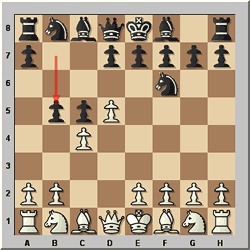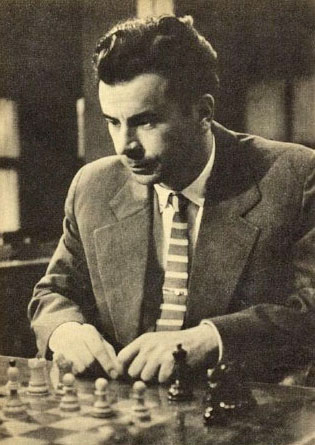Study Composing Secrets (2)
By GM Pal Benko

Breaking the pin

[Event "Chess Clinic 1st International Tourney"] [Site "?"] [Date "2000.??.??"] [Round "?"] [White "Benko, P."] [Black "White to play and win"] [Result "1-0"] [Annotator "Benko,Pal"] [SetUp "1"] [FEN "1QR5/5p2/1qr3p1/6P1/4K3/6P1/1k6/8 w - - 0 1"] [PlyCount "29"] [EventDate "2013.09.26"] 1. Qe5+ Kc1 $1 {This move parries the motif presented in the previous example by which} (1... Kc2 2. Qd6 $1 {wins.}) 2. Rb8 $1 ({Now after} 2. Qd6 $2 Qb1+ $1 3. Ke3 Qb3+ {and Rxc8 would come.}) 2... Rc4+ 3. Kd3 Rd4+ 4. Kc3 ({In case of} 4. Qxd4 $2 Qxb8 5. Qa1+ (5. Qf4+ Qxf4 6. gxf4 Kd1 7. Ke4 Ke2 8. f5 gxf5+ 9. Kxf5 Kf3 $11) 5... Qb1+ 6. Qxb1+ Kxb1 7. Ke4 Kc2 8. Ke5 Kd3 9. Kf6 Ke4 $11 { creating zugzwang is equal.}) 4... Qd6 ({Otherwise} 4... Re4 5. Qxe4 Qc7+ 6. Qc4 {wins for White}) 5. Qe3+ ({The obvious} 5. Qxd4 $2 Qxg3+ 6. Qd3 Qe5+ $11 { draws.}) 5... Rd2 6. Rb4 $1 {This brings Black to the cross-roads.} f5 ({Now} 6... Qd5 7. Qg1+ Rd1 8. Rb1+ $1 Kxb1 9. Qb6+ {mates.}) (6... Qd8 7. Rc4 Qd5 8. Rc8 $1 {wins as in the main line.}) ({Another alternative is} 6... f6 {but} 7. Ra4 Qe5+ 8. Qxe5 Rc2+ 9. Kd3 fxe5 10. Ra1+ Kb2 11. Ra2+ Kxa2 12. Kxc2 {wins}) 7. Ra4 Qc6+ 8. Rc4 Qd5 9. Rc8 {Mutual Zugzwang} Qd7 (9... Kd1 10. Qg1+ Ke2 11. Re8+ {wins}) 10. Rc5 $1 Qd6 11. Kb3+ Kd1 12. Rc1+ $1 Kxc1 13. Qe1+ Rd1 14. Qc3+ Kb1 15. Qb2# 1-0
It is a sharp study with unexpected reposts, quiet moves in spite of having strong material, which is unusual. It was interesting that the judges at this tourney were the competitors themselves, giving points evaluating each entry. The well-known IM V. Afek wrote that mine was "one of the best studies of all times!"

Chess players liked the rook sacrifice at the end therefore I followed the ice-cream theory (little Steven is asked what he liked most; he answered that it was ice-cream. But there may be something you like better? Yes, two ice creams…).
The more you eat the more you want

[Event "Magyar Sakkelet 1-2 Prize"] [Site "?"] [Date "2000.??.??"] [Round "?"] [White "Benko, Pal"] [Black "White to play and win"] [Result "1-0"] [Annotator "Benko,Pal"] [SetUp "1"] [FEN "8/r5k1/2p5/3PK2R/6p1/3q4/8/4Q3 w - - 0 1"] [PlyCount "25"] [EventDate "2013.09.26"] 1. Rg5+ Kf8 ({A neat win comes after} 1... Kh8 $2 2. Qh1+ Rh7 3. Qa1 $1 Rg7 { since after any checks of Black would be answered by a winning discovered check } 4. Rh5+ Kg8 5. Qa8+ Kf7 6. Rf5+ {wins.}) 2. Qb4+ ({But not} 2. Qf2+ $2 Rf7 3. Qc5+ Re7+ 4. Kf6 Qh7 {and Back escapes.}) 2... Re7+ 3. Kf6 Qe4 {The best defense.} ({In case of} 3... Qh7 $2 4. Rg8+ $1 Kxg8 5. Qb8+ {mates}) 4. Rh5 $1 Qf3+ 5. Rf5 Qe4 $1 {So that the rook gets pinned after Kg6+ is played.} ({After } 5... Qe3 6. Qb8+ Re8 7. Qc7 Re7 8. Kg6+ Kg8 9. Rf8+ Kxf8 10. Qd8+ Re8 11. Qf6+ {there is a mating motif we have already seen.}) 6. Qb8+ Re8 7. Qc7 Re7 ({ In case of} 7... Qe7+ 8. Kg6+ Kg8 9. Re5 $3 {wins}) 8. Qc8+ $1 Re8 9. Kg6+ Kg8 10. Qc7 Re7 11. Qd8+ Re8 12. Qh4 $1 Qe7 (12... Re7 {is met by} 13. Qf6) 13. Rf8+ $3 {and mate or queen loss - the grand finale with a thematic triple rook sacrifice.} 1-0
GM I. Bilek published my study in his column. Its title was “The most beautiful endgame of the century.” The FIDE album is issued every three years with selected compositions judged by four International Arbiters. My study came first, topping more than 600 others.
Always room for improvement
It has pleasure for me to correct old works as well as supporting newcomers. The author Henk Nieland mentioned that he had found the idea from a game Anatoly Karpov played in Tilburg. Indeed it looks like a game, but for a study it is quite short and should not start with taking a piece. He liked the new composition and gave me tickets to a comic opera with music by him. Each composition (like each book, according to a Latin saying) has its own story.

[Event "(NED)"] [Site "?"] [Date "????.??.??"] [Round "?"] [White "Nieland, Henk"] [Black "Black to play and draw"] [Result "1/2-1/2"] [Annotator "Benko,Pal"] [SetUp "1"] [FEN "2q4k/2r3pp/8/4Q3/1p1B2N1/rR4P1/2P2PP1/6K1 b - - 0 1"] [PlyCount "11"] [EventDate "2013.09.26"] 1... Rxb3 2. cxb3 Rc1+ 3. Kh2 Rh1+ $1 4. Kxh1 Qc1+ 5. Kh2 Qh6+ $1 6. Kg1 (6. Nxh6 {stalemate}) 6... Qc1+ {Draw by perpetual check or stalemate.} 1/2-1/2
Using this idea by Henk Nieland, who got it from a Karpov game, Pal Benko composed the following study, which we leave you to solve yourself. You have all the information required to do so, and will be deeply satisfied when you succeed.
Henk Nieland/Pal Benko

White to play and win
Solution

[Event "(NED)"] [Site "?"] [Date "????.??.??"] [Round "?"] [White "Henk Nieland/Pal Benko"] [Black "White to play and win"] [Result "1-0"] [Annotator "Benko,Pal"] [SetUp "1"] [FEN "7k/6pp/2q5/4Q3/r5N1/2r3P1/5PR1/2B3K1 w - - 0 1"] [PlyCount "29"] [EventDate "2013.09.26"] 1. Bb2 Rc1+ (1... Ra1+ $2 2. Kh2 $1 (2. Bxa1 $2 Rc1+ 3. Kh2 Qh6+ 4. Nxh6 Rh1+ 5. Kxh1 {stalemate}) 2... Rh1+ 3. Kxh1 Rc1+ 4. Bxc1 {wins}) 2. Kh2 $1 (2. Bxc1 Qxc1+ 3. Kh2 Qh6+ $1 4. Nxh6 Rh4+ 5. Kg1 Rh1+ 6. Kxh1 {stalemate}) 2... Qh6+ $5 3. Nxh6 Rh1+ (3... Rh4+ 4. gxh4 Rh1+ 5. Kg3 Rh3+ 6. Kf4 $1 Rf3+ 7. Kg5 Rg3+ 8. Ng4 {wins}) 4. Kxh1 Rh4+ 5. Rh2 $1 Rxh2+ 6. Kg1 $1 Rg2+ 7. Kf1 Rxf2+ 8. Ke1 Re2+ 9. Kd1 $1 Rd2+ (9... Rxe5 $2 10. Nf7+ {would win.}) 10. Kc1 Rc2+ 11. Kb1 Rxb2+ 12. Kc1 $1 Rc2+ 13. Kd1 Rd2+ 14. Ke1 {wins, since after} Re2+ ({After} 14... Rd1+ {the White king escapes and there is no more perpetual checks.}) 15. Qxe2 {may come and there is no stalemate without the bishop.} 1-0
The Benko Gambit
1.d4 Nf6 2.c4 c5 3.d5 b5

In The Benko Gambit by P. Benko (New York, 1973) the author wrote: ‘It is hardly possible to state precisely who first adopted the gambit. Some Swedish sources mention that it first occurred there in the 1920s and that tournaments especially for the gambit were organized later. The three internationally known masters of Sweden’s past – Ståhlberg, Stoltz and Lundin – also used it, although Ståhlberg found it not to his taste either as White or as Black. Indeed, the Swedish players appear to have used the king’s-side fianchetto, if not the modern order of moves. Of course, the gambit may have occurred elsewhere as well, but it was undoubtedly Lundin who introduced it into international tournament practice. Nevertheless, it later fell into oblivion.' |
|
Some earlier ChessBase articles on Pal Benko
12/17/2013 – Pal Benko: Secrets of Study Composition (1)
There is more to chess than tournament games. The area of chess studies and problems is equally creative and breathtakingly imaginative. One of its greatest composers is grandmaster (and world championship candidate 1959 + 1962) Pal Benko. The 85-year-old author of some of the most famous studies of all time has sent us an essay on the remarkable process of chess composition.
7/15/2013 – The Life Gambit à la Benko
Pal Benko (Hungarian: Benkö Pál) is, as 99% of our readers probably know, a legendary chess grandmaster, author, and composer of endgame studies and problems. He was born on July 15 1928, which made him 85 today. Diana Mihajlova met the fit and active octogenarian, who has been a "pal" of our company for a decade, in his home town of Budapest. Here is part one of her birthday report.
7/18/2013 – The Life Gambit à la Benko – Part two
On Monday Pal Benko, legendary grandmaster, author, and problem composer, turned 85. Diana Mihajlova, who recently met with the fit and active octogenarian in his home town of Budapest, sent us a birthday report in two parts. Today we learn of Benkos escape from Communist Hungary to the US, and his relationship with Bobby Fischer. And we get to solve two highly entertaining problems.
5/20/2011 – Greetings from Pál Benkö for 25 years of ChessBase
"Congratulations to ChessBase on your 25th anniversary! Your news page is the the first thing I look at every day when I go on the Internet. You do such wonderful work. Keep up your great service for the whole chess world." Heartening words from legendary great chess player, theorist, author and problem composer – who in addition sent six anniversary puzzles for our readers.
4/24/2011 – Easter puzzles by Benko – a World Champion challenge
Pál Benkö, 82 and still going strong, is a world class grandmaster, author and problem composer. He is also a faithful friend who periodically sends us puzzles for our newspage. This time, for Easter, he has selected four problems which stumped a World Champion. It is a challenge for you to do better, and win a special prize in the process. Enjoy.
12/30/2009 – Pal Benko improves on Troitzky
In 1856 the great Sam Loyd composed a chess problem, which 75 years later inspired Alexey Troitsky, one of the greatest composers of endgame studies, to create a puzzle with a similar theme. It proved to be flawed. 75 years after Troitzky another great composer, Pal Benko, took up his problem, improved on it and submitted it for our Christmas Puzzle page.





























